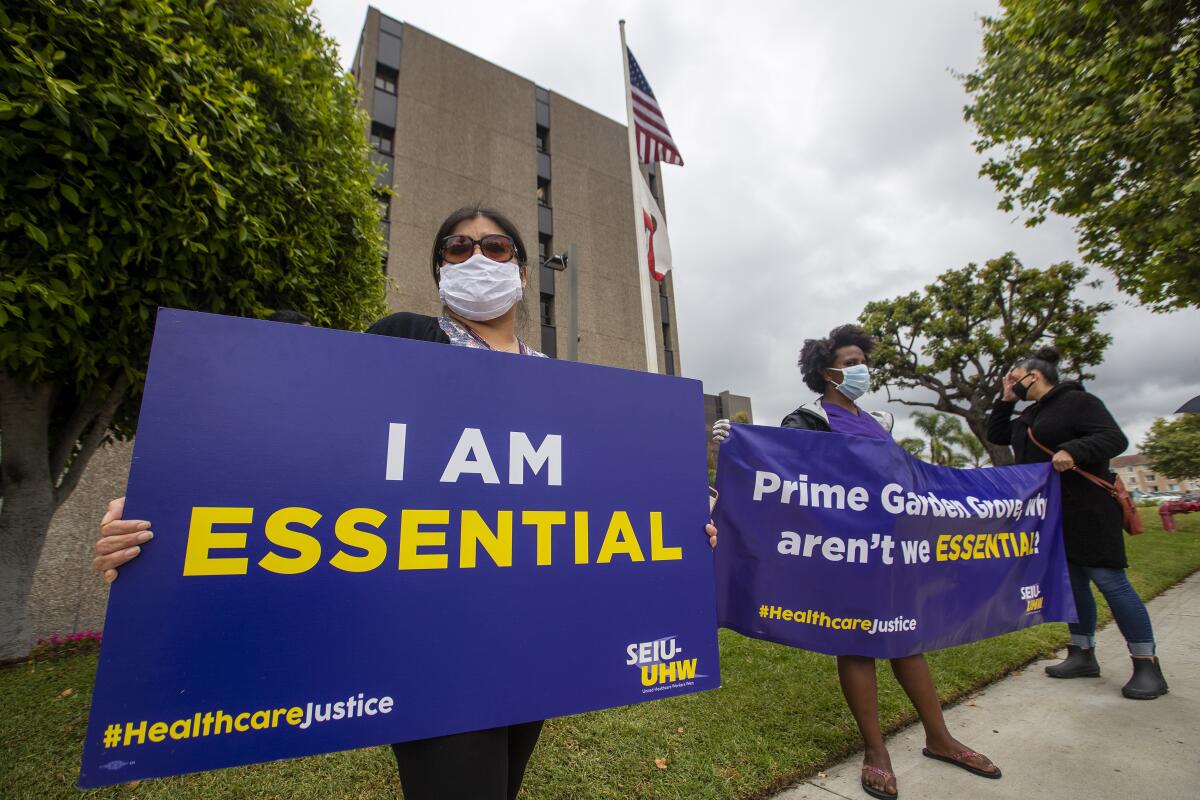Cal/OSHA will create emergency COVID workplace safety rules

- Share via
After months of discussion, California’s Division of Occupational Safety and Health will move forward with emergency statewide standards to address what worker advocates have been calling “an occupational health emergency.”
A seven-member board appointed by Gov. Gavin Newsom voted unanimously Thursday to begin creating standards that would require employers to take stricter precautions against COVID-19.
“It’s really impossible for anyone to claim this is not an emergency and not a significant problem we need to address,” board member Laura Stock, an occupational health expert, said in urging her colleagues to vote yes.
The board oversees standards enforced by the agency, better known as Cal/OSHA.
The board’s decision jump-starts a fast-tracked process that could result in emergency statewide workplace requirements in a matter of months. It also opens a door for potential permanent changes relating to all infectious diseases, including any future “novel pathogens.”
“This is a great win for California workers,” said Stephen Knight, director of Worksafe, the advocacy group that filed the petition in May. He hailed the decision as a step in the right direction as California continues to grapple with outbreaks at meatpacking plants, nursing homes and prisons.
A rare and little-known state provision enacted in 2009 requires employers to protect California’s healthcare workers against the transmission of airborne diseases. But no such policy exists for other workers. Knight noted that “essential” workers have faced increased risks as a result of the pandemic and are more likely to be low-wage earners, people of color or immigrants.
The board didn’t specify what rules it intends to create or which workplaces will be affected. Specific requirements will be hashed out in the weeks to come.
Statewide, there have been more than 773,000 confirmed cases of the virus and more than 14,700 COVID-19 deaths. It’s unclear exactly how many of those infections stem from occupational exposure because the state does not track cases by workplace.
The proposal was backed by a coalition of worker rights groups, unions and environmental groups. It faced staunch opposition from business interests that called any additional requirements unnecessary and “duplicative.”
“Recalcitrant employers who are not following existing requirements are certainly not going to follow new ones,” said Elizabeth Treanor, director of the Phylmar Regulatory Roundtable, which represents corporations. “There is no evidence a new rule would improve compliance.”
The board itself had initially recommended against the adoption of emergency rules, siding with business concerns that new regulations could be burdensome. That was at odds with Cal/OSHA officials, who said that clear emergency rules could enable the agency to take a harder line on employers during the pandemic.
For months, worker advocates have criticized Cal/OSHA for anemic enforcement and failing to take action against employers flouting safety guidelines.
Several workers and union officials joined the Thursday meeting to provide accounts of workplace conditions. One worker coordinator said an employer was charging employees for face masks they were required to wear on the job.
In recent weeks, Cal/OSHA has taken steps to ramp up enforcement. This month the agency announced it was proposing more than $500,000 in fines against a frozen foods company and a temporary staffing agency for failing to protect hundreds of workers at two facilities in Vernon.
The agency is also hiring retired inspectors after articles by The Times chronicled understaffing within Cal/OSHA’s ranks.
“The agency is going to need to be able to rise to this moment,” Knight said. “I’m optimistic that we can all work together to make this happen.”
More to Read
Get the L.A. Times Politics newsletter
Deeply reported insights into legislation, politics and policy from Sacramento, Washington and beyond. In your inbox twice per week.
You may occasionally receive promotional content from the Los Angeles Times.











